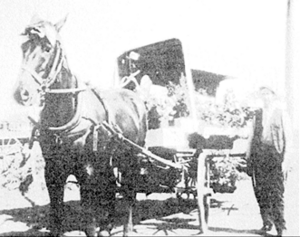Carnation Gold Rush facts for kids
The "Carnation Gold Rush" was a special time in Colorado. It happened between the 1880s and 1930s. During this period, the business of growing and selling flowers, especially carnations, grew very big in Denver. People called it a "gold rush" because it brought a lot of success, just like finding gold!
Contents
How the Flower Business Started
In the 1860s, the search for gold and silver in Colorado was slowing down. Many people who didn't get rich looked for new ways to make money. They wanted to provide goods and services to the growing city of Denver.
In 1872, Denver built an irrigation ditch. This ditch brought water from the Platte River Canyon to the city. With plenty of water, growers found that Denver's sunny days and rich soil were perfect. They could grow lots of vegetables and beautiful cut flowers.
At first, there were only a few types of carnations. Many growers sold their flowers directly from their greenhouses. Others sold them to flower shops. The weather was a challenge. In winter, they used charcoal heaters in delivery wagons to stop flowers from freezing. In summer, they fought against intense heat that could make flowers wilt. Even with these problems, the flower business grew quickly.
Denver's First Flower Shops
The very first greenhouse in Denver was built in 1891. By 1900, the flower industry had about 400,000 square feet of greenhouse space. That's a lot of glass!
Some of the first places that sold carnations to the public were:
- The Mauff Floral Company, started in 1880.
- Riverside Cemetery (which also had a floral business).
- Colfax Floral.
- Park Floral.
- Curtis Park Floral.
This was the start of Colorado's Carnation Gold Rush.
Making Carnations Famous
In the early 1900s, a system was created to market and grade carnations. N.A. Benson, a Swedish immigrant, started the Denver Wholesale Florist. He realized that Colorado carnations were very valuable. They could be sold all over the country. He helped set standard prices and made sure all growers produced high-quality flowers.
Around this time, J. Edward Johnson from Pikes Peak Floral Company in Colorado Springs began shipping Colorado carnations to other states.
Later Years and National Fame
In 1917, George Brenkert of Washington Park Floral created a new pink carnation called "Denver." It didn't win an award right away. But it later won a Bronze Medal at the 1921 National Flower Show in Washington, D.C. Colorado was becoming famous for its carnations and cut flowers.
President Elect Harding wore a Colorado carnation on his inauguration day. He was following a tradition started by President William McKinley. President McKinley always wore a red carnation. He even ordered fresh ones daily. January 29, McKinley's birthday, is still known as the official Carnation Day.
By 1919, the value of flower sales in Colorado was over $1.1 million. This was reported by the 15th U.S. Census.
From 1925 to 1927, the amount of greenhouse space in Colorado more than doubled. By 1926, Colorado produced about 8 million carnation blooms.
By 1927, Colorado's flower industry was shipping to 20 states. There were about 5 million square feet of greenhouse glass in the state. Colorado was quickly becoming known as "the carnation state." This was because of the excellent quality of the flowers. Also, they could be grown all year round. In 1927, the flower industry was first mentioned in the Colorado Year Book. This book was published by the Colorado State Planning Division.
In 1928, Colorado grew 12 million carnation blooms. Ten states depended completely on Colorado for their flower supplies.
By 1929, there were 101 flower businesses in Colorado. They had over 1.5 million square feet of carnation beds. The total income from Colorado's flower industry was about $5 million. This was more than the value of gold mined that year! Colorado became famous for its carnations. They had "brilliant color, unusual size, and lasting quality." Colorado carnations were even sent to New York, London, and Cuba.
By 1931, Colorado was one of the most important states for growing flowers. This included carnations, Roses, and Gypsophilia (Baby's Breath).
Local greenhouses kept growing, especially in northwest Denver and its suburbs. Wheat Ridge, Colorado still has an annual Carnation Festival. New types of carnations were created, like the White Ward and Hilda varieties.
The early growers in Denver started an industry that changed Colorado's economy and landscape. They helped create a system to provide high-quality cut flowers to the whole country and beyond. Some of the families known for their part in the Carnation Gold Rush include Amato, Elitch, Lambourn, Lehrer, Maler, and Spano.
Categories


